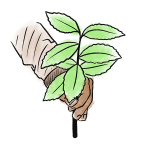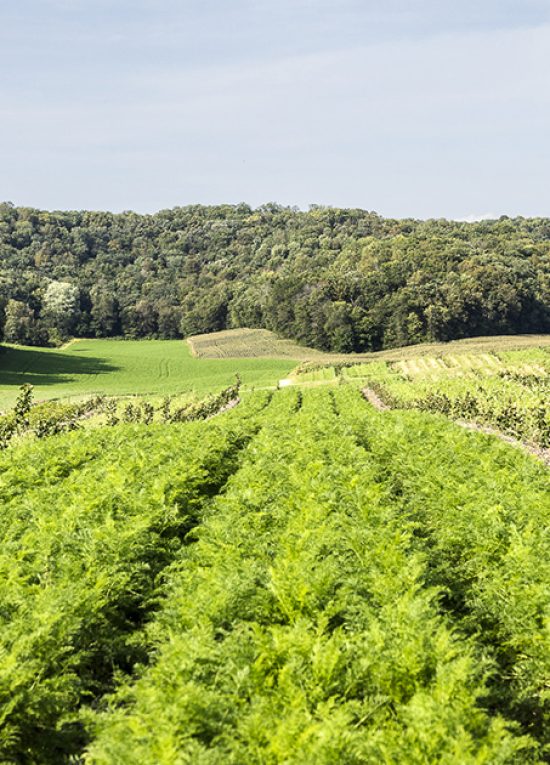Nightfall Farm
Crothersville, IN
Mentor Farm
Agroforestry Systems:
Silvopasture
Farm Information
Nightfall Farm is a pasture-based livestock farm in southeast Indiana. Farm owners Liz and Nate Brownlee believe that small farms can help rebuild rural places. For them, rebuilding means bringing Liz’s family land back to life, selling food in small communities, and connecting people through food. The Brownlees rotationally graze meat chickens, laying hens, pigs, turkeys, and sheep on about 50 acres of young silvopasture, which includes about 1,000 native and cultivar trees. Grazing is a way to build up the health of the soil, respect animals, and produce high-quality meat and eggs. The Brownlees sell the meat via its 50-family CSA, two local farmers markets, and to small restaurants and groceries. The farm added 400 native trees around 2014, and 300 more in 2020. Nightfall Farm also has a half-acre elderberry planting that is bearing fruit, as well as 1,700 feet of shrub willows. The willows are a major source of shade for the livestock and habitat for wildlife – plus the Brownlees sell willow cuttings to basket-makers and casket-makers. In their farm plan, the Brownlees hope to expand its market to include florists and also start selling propagation materials to area farmers and gardeners.
Owners: Liz and Nate Brownlee
On-Farm Training Opportunities
This is our third year hosting Savanna Institute apprentices, and we’ve hosted interns for five years before that. We really believe in sharing knowledge. We have had excellent mentors, and we want to pass that learn-by-doing goodness along. Our trainee will help with all aspects of a pasture-based livestock farm and our silvopasture plantings. Our farm is built around animals, and so that is the focus of our daily work. Each day starts and ends with chores (caring for our sheep, chickens, pigs, and turkeys). Tasks include feeding, watering, rotational grazing (building new paddocks with temporary electric net-fencing) and observing (time spent with animals helps with socializing but also helps to catch problems quickly). This work is repetitive but joyful.

Availability: Open
Many of our tasks will be performed together, but the plan is to effectively train our apprentice to be capable and confident to work alone as needed, and so they leave our farm feeling more prepared to launch their own agroforestry farm. Each day will also include project time (typically working in collaboration with one of us). Projects might include work on farm infrastructure, working in the garden, mucking or washing feeders and waterers between groups of chickens or turkeys, or tackling whatever the farm needs on a given day. Project time will also focus on other regenerative practices beyond livestock. Our trainee will help take on some of our goals for 2023: maintenance for our new silvopasture tree plantings, overhauling our elderberry planting, and our second round of harvest/maintenance on 1700’ feet of shrub willows.
Per the tenants of WWOOF, while you are our apprentice, we will not think of you as just our laborer. We commit to teaching you what we know, providing experience in/with all aspects of our farm, and allowing you the time to be a human being in southern Indiana. We have a bike and kayak that you may borrow, as well as a good library. Our farm includes 150 acres of forest and wetlands, and a hiking trail for you to enjoy as well.
Timing
Our training lasts 10 weeks and you should be expected to work 24 hours per week, most often 3 8 hour days. The apprenticeship can be any 10 consecutive weeks starting as early as April 1 / ending as late as October 31. We may be flexible about the start date for the right candidate.
Qualifications
- Excited by small-scale, diversified farming
- Mature, disciplined, and thoughtful
- Enjoys physical work
- Comfortable working in hot, cold, wet, dry, and everywhere in between
- Able to lift 50 pounds and do 8 hours of physical work per day
- Has the physical endurance to farm
- Experience with animals preferred but not required
- Comfortable getting dirty, being outside (which means beautiful sunsets as well as bugs, and meaningful work as well as sweat)
- Be committed to finishing the apprenticeship.
Benefits
- Pay: In exchange for work, we provide room and board here on the farm plus we pay $10 per hour. Housing details below. Board includes breakfast and lunch every work day. Apprentices are responsible for their own for snacks and dinners on work days, and are responsible for all of their meals/snacks on their four days off per week.
- Housing: We have two housing options: We have a small cabin with a porch, electricity, lots of windows, and the basics (queen bed, shelves, chair, etc.) as well as a 13’ canvas bell tent on a tent platform in our woods, outfitted with a queen air mattress on a cot, solar lights, shelves, chair, etc. Both options utilize composting toilets. The trainee will have access to an outdoor kitchen (including a propane cooking range and running water) and outdoor heated shower. Neither housing option has access to the internet, but the trainee can access WIFI from our farmhouse deck (with table and shade) during daylight hours. If we hire two trainees, whichever trainee we hire first gets to choose their housing first.
- Food: We eat simple meals that are heavy with veggies and often include our meat and eggs. We provide omnivorous breakfast and lunch on your work days, and we can accommodate a vegetarian diet easily. When we eat together, we share the responsibilities for prep and clean up. When you eat on your own, you will have access to the outdoor kitchen, which is equipped with basics like pots and pans, plates, bowls, silverware, wooden spoons, tea kettle, etc. We can provide details!
- Remoteness: We feel remote, but we can also access conveniences pretty easily. We are located about an hour north of Louisville, about an hour south of Indianapolis, so things like concerts and museums are a short drive away. We are about 20 minutes from the nearest town big enough to have grocery stores, restaurants, etc., so you’ll need your own transportation for a successful time here at our farm. We also encourage you to check out the many good hikes, pollinator habitat, and waterfalls within a 45-minute drive. Our farm is on a dead-end road, and so we only see people outside of our family when we leave. We encourage you to bring a mountain bike or hybrid road bike to zip around the farm for chores and projects (but we also have bikes you can borrow during your time here at Nightfall).
Support Our Work
Sponsor a Trainee
Your gift could provide experience and technical education for aspiring farmers through on-farm training with a mentor farmer and community building opportunities for farmers, trainees, and those interested in incorporating trees on farmland.







